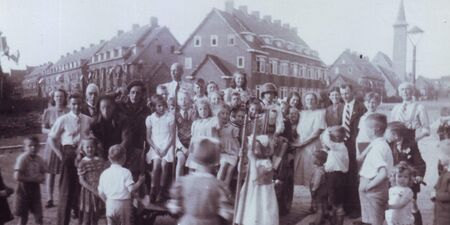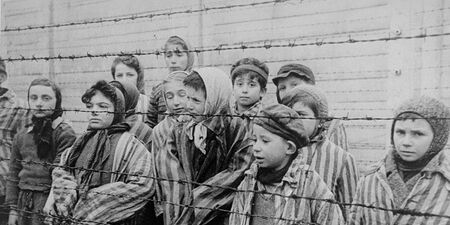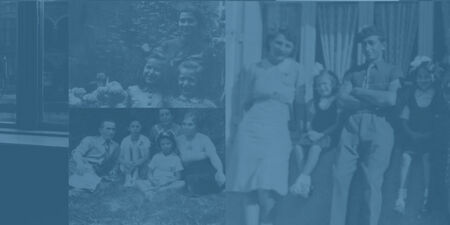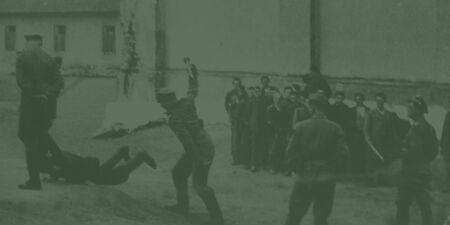Blog

New Online Activity: Liberation Through the Eyes of a Hidden Child
In this activity, students will use testimony to learn about Claire Baum's experiences in hiding during the Holocaust, her moment of liberation and her life after liberation.

Introduce your students to the Human Experience of Auschwitz on International Holocaust Remembrance Day
This human-centred learning helps students approach the history of the Holocaust in the most effective way. Personal accounts, when carefully grounded in their specific contexts, enable students to recognize the multiplicity of stories that make up this historical event. Students form connections with survivors when they learn about the ordinary lives they lived that were disrupted by war and genocide. And when students study the impact of the Holocaust on individuals, they develop historical empathy by understanding how people navigated their way through an unprecedented historical situation. Read more about our Educational Philosophy. The pedagogical goals of this activity are to gain knowledge of and to reflect on the lived experiences of prisoners at one of the most significant sites during the Holocaust.Survivor accounts of Auschwitz include discussion of immense suffering and death, so we ask teachers to take into consideration the maturity of their students and recommend this activity for students ages 15 and up.Auschwitz“Most of what I will tell you here I experienced personally or saw with my own eyes. I will also tell you some things that other people told me, and rumours that I heard. Yet, having finished this memoir, I reflect on the fact that long after the survivors, including myself, are gone, historians will continue to write about the Holocaust, especially about Auschwitz. But they will never really know everything about the camp because nobody ever really knew everything about Auschwitz.” — Felix OpatowskiAuschwitz was a Nazi concentration camp complex built between 1940 and 1942 in German-occupied Poland. The largest camp complex established by the Nazis, Auschwitz contained three main camps: Auschwitz I, a concentration camp; Auschwitz II (Birkenau), a death camp that used gas chambers to commit mass murder; and Auschwitz III (Monowitz), which provided slave labour for an industrial complex. In 1942, the Nazis began to deport Jews from almost every country in Europe to Auschwitz, where they were selected for slave labour or for death in the gas chambers. In mid-January 1945, close to 60,000 inmates were sent on a death march to other Nazi camps away from the advancing Allied armies, leaving behind only a few thousand inmates too weak to travel, who were liberated by the Soviet army on January 27, 1945. It is estimated that 1.1 million people were murdered in Auschwitz, approximately 90 per cent of whom were Jewish; other victims included Polish prisoners, Roma and Soviet prisoners of war.We believe that taking this human-centred approach to learning about Auschwitz will stimulate your students’ interest in learning more about the Holocaust.Classroom InstructionsPurpose and learning outcome: This inquiry-based activity encourages students to participate in knowledge-gathering by providing guided research questions that span the range of common experiences at Auschwitz: deportation, arrival and selection, daily life, resistance, and death marches. In small groups, students will research different questions related to this topic and then present their findings to the class. As part of a collaborative learning process, each group will contribute an essential piece of knowledge, so that the class as a whole develops a fuller picture of this complicated site. Your students will learn about the diversity of lived experiences at Auschwitz from a group of men and women, some of whom were quite young at the time, who arrived at Auschwitz from Poland, Czechoslovakia and Hungary. Required resources: Each group will need access to an internet-enabled computer or tablet, and the classroom will need to be equipped with a screen.Length of time: Approximately one class period.Instructions:Introduce your students to Auschwitz with this encyclopedia article from the United States Holocaust Memorial Museum. Divide students into five groups and assign each group a research question and a related list of recollections to view. Play the Re:Collection instructional video for students. Allow students time to explore Re:Collection with the instruction to watch the short introduction to the Holocaust video on the menu,and to locate the Auschwitz Special Collection. All of the recollections students need to view can be found within the Auschwitz Special Collection.When all groups are finished, ask each group to explain their answer to the research question they were given. Groups should introduce one of the survivors they encountered and present one of that survivor’s recollections as evidence for their answer. Research Questions and Recollections Group 1. Research question: What did people experience immediately before and during deportation to Auschwitz?View these recollections: John Freund, “Train to Auschwitz”; Anna Molnár Hegedüs, “Deportation”; and one more recollection of your choosing that you find by exploring the Auschwitz Special Collection.Hint: as you view these recollections, consider how people experienced the physical, mental and emotional effects of these journeys to an unknown destination.Group 2. Research question: What happened upon arrival at Auschwitz?View these recollections: Nate Leipciger, “Selection”; Helena Jockel, “The Selection”; and one more recollection of your choosing that you find by exploring the Auschwitz Special Collection.Hint: as you view these recollections, consider how age affected how people made sense of what was happening to them and their families at this strange new location.Group 3. Research question: What were the living conditions like in Auschwitz?View these recollections: Nate Leipciger, “The Rules of Auschwitz”; Helena Jockel, “Living Conditions at Auschwitz”; and one more recollection of your choosing that you find by exploring the Auschwitz Special Collection.Hint: as you view these recollections, consider how the living conditions in Auschwitz were designed to dehumanize the prisoners.Group 4. Research question: In what ways did Jewish prisoners try to resist the cruel conditions they faced in Auschwitz?View these recollections: Felix Opatowski, “Uprising”; Helena Jockel, “Resistance in the Women’s Camp”; and one more recollection of your choosing that you find by exploring the Auschwitz Special Collection.Hint: as you view these recollections, consider how risky it was for prisoners to engage in resistance activities in Auschwitz.Group 5. Research question: What is a death march? Why did the Nazis force prisoners on death marches and what were the conditions prisoners faced during this phase of the Holocaust?View these recollections: Anna Molnár Hegedüs, “Death March”; John Freund, “Death March”; and one more recollection of your choosing that you find by exploring the Auschwitz Special Collection.Hint: Find the definition of “death march” in the glossary by clicking More Info. As you view these recollections, consider how this final phase of the Holocaust compared to imprisonment in Auschwitz.Next StepsAre you interested in extending your students’ learning about the Holocaust? Here are a few ideas:• Assign one or more of our memoirs to your class. See a complete list here, and feel free to contact us for suggestions based on the age and needs of your students. Our books are free of charge for teachers and students, and available in French and English. • For a more in-depth engagement with Holocaust history, implement our six-lesson unit of study on Hidden Children, Identity and the Holocaust.• Investigate whether there is a local Holocaust education centre in your province. • Contact us to arrange a Professional Development session for teachers in your city to learn more strategies for bringing personal accounts from Canadian Holocaust survivors into your classroom.We’d love to hear from you. Get in touch to let us know how your students responded to Re:Collection and what you’d like to see from us in the future.

Hidden Children, Identity and the Holocaust: Surviving in the Margin of the Catastrophe
We know that teachers want to provide in-depth and engaging units on the Holocaust but might be unsure where to begin. How do you select a topic on the Holocaust that is both appropriate for your classroom and relatable to your students? We provide the resources to engage students by immersing them in this history through personal accounts and digital media. Based on research into curricular needs across Canada and drawing on both critical and historical thinking resources that were developed by leading Canadian educators, we designed a six-lesson Education Program on the topic of hidden children, identity and the Holocaust. The Education Program is available in English and French and can be adapted to the needs of your classroom. Click on each image to open the Teacher’s Guide to the Education Program and the Student Reading Guides and Worksheets: For more download options, visit our Resources for Educators Page The Education Program teaches students about the history of the Holocaust through the stories of individual survivors who lived as hidden children and who later immigrated to Canada. Students each read one memoir and use Re:Collection, our interactive digital resource, to explore “recollections” (video clips, memoir excerpts, photographs and artifacts) related to their author. In small group discussions, students explore the concept of identity to develop an appreciation for how people in the past formed their identities, how their identities were attacked and suppressed during the Holocaust, and how these experiences affected their lives as adults in Canada. As a class, students then examine primary sources to consider the context of rising discrimination and persecution of Jews as a catalyst for decisions to go into hiding. Depending on the classroom subject, students have the option to create either a timeline or a newspaper article. By the end of the Education Program, students understand the variety of ways that Jewish children experienced the Holocaust in hiding and demonstrate awareness of the value and challenges of using personal accounts to study this history.The Education Program is based on the memoirs by Judy Abrams, Claire Baum, René Goldman, Muguette Myers, Arthur Ney, and Marguerite Élias Quddus; teachers and students can complete the Education Program using any one or any combination of these memoirs. These authors lived in different countries in Europe, and their ages and experiences in hiding varied widely. The Azrieli Foundation’s education and outreach team can guide you through the implementation of the Education Program in your classroom. We may be able to arrange a Skype call or even a visit to your classroom by one of the survivor authors, depending on where in Canada you are located, as a conclusion to the Education Program. Today’s students are part of the last generation to hear testimony directly from survivors, and the Education Program provides the necessary preparation for students to understand the historical context of a survivor’s testimony.

Understanding What Genocide Really Means
Defining Genocide Article II of the United Nations Convention on the Prevention and Punishment of the Crime of Genocide define...

